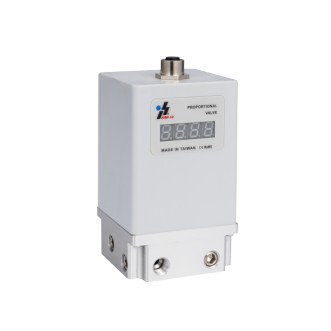 |
QKL-B4H-P18(261 psi)
|
QKL-B4H-P60(870 psi)
|
QKL-B4H-P70(1015 psi)
|
Description
QKL-B4H pressure controller is a device used to maintain or control the pressure of a fluid (such as gas or liquid) within a desired range. It is commonly used in industrial and manufacturing processes where maintaining a constant pressure is critical to ensuring quality and consistency in the end product.
KaoLu's controller features high speed, high accuracy 0.05% F.S, and high resolution 1kPa, and most importantly ultra-stable at target pressure. Customers have used our electronic controller to replace expensive dekstop pressure controller (consult for customised spec).
Pressure controllers typically consist of a pressure sensor, a control circuit, and an actuator. The pressure sensor measures the pressure of the fluid and sends a signal to the control circuit. The control circuit then compares the measured pressure to the desired set point and sends a signal to the actuator to adjust the pressure accordingly.
There are different types of pressure controllers, including mechanical, pneumatic, and electronic controllers. Mechanical controllers use a mechanical feedback mechanism to control the pressure, while pneumatic controllers use air pressure to adjust the pressure of the fluid. Electronic controllers use electronic feedback to adjust the pressure, and they can be more precise and flexible than mechanical or pneumatic controllers.
Some common applications include controlling the pressure in pipelines, regulating the pressure of gases in a semi-conductor equipment such a MOCVD equipment, or maintaining the pressure in a pneumatic system.
Electronic Pressure controllers are widely used in various industrial and scientific applications where precise control of pressure is required. Some common applications are:
- Manufacturing: used in manufacturing processes to control and regulate pressure in different stages of the production process, such as injection molding, extrusion, and coating.
- Research and Development: used in research and development laboratories to create and maintain precise atmospheric conditions required for experiments and testing.
- HVAC Systems: used in heating, ventilation, and air conditioning (HVAC) systems to maintain proper air flow and pressure in the system.
- Medical Equipment: used in medical equipment, such as respirators, anesthesia machines, and blood pressure monitors, to maintain a constant and precise pressure.
- Automotive: used in automotive systems, such as fuel injection, airbag deployment, and tire pressure monitoring, to control and regulate pressure.
- Semiconductor: used in MOCVD applications to maintain the pneuamtic pressure in and flow rate.
- Food and Beverage Industry: used in food and beverage production and processing to maintain proper pressure in different stages of the process, such as bottling and canning.
Overall, electronic pressure controllers play a critical role in maintaining precise pressure in various industrial and scientific applications, ensuring the safety, quality, and reliability of the end product.
Specifications
| Type | B4H-P18(261psi) | B4H-P60(870psi) | B4H-P70(1015psi) |
|---|---|---|---|
| Input Signal | 0-10V / 4-20mA /RS485 | ||
| Output Range | 0-18bar (260 psi) | 0-60bar (870 psi) | 0-70bar(1015 psi) |
| Supply Pressure Max | 20bar (290 psi) | 65bar (942 psi) | 74bar(1073 psi) |
| Monitor Output | 0-10V / 4-20mA | ||
| Supply | DC24V (≦4W) | ||
| Response | 200 msec | ||
| Medium | Clean compressed air or with 5 μm filter | ||
| Repeatability | ±0.25% F.S. | ±0.25% F.S. | ±0.25% F.S. |
| Hysteresis | ±0.25% F.S. | ±0.25% F.S. | ±0.25% F.S. |
| Linearity | ±0.25% F.S. | ±0.25% F.S. | ±0.25% F.S. |
| Accuracy | ±0.25% F.S. | ±0.25% F.S. | ±0.25% F.S. |
| Sensitive | 0.1bar | 0.5bar | 0.5bar |
| Flow Rate | 40L/min @ 18bar | 145L/min @ 60bar | 170L/min @ 70bar |
| Temp. Range(Operating) | -196 ~ 70 ⁰C ( -320 ~ -158 ⁰F) | ||
| Port Size | 1/8"PT | ||
| Manifold Material | Aluminum | ||
| Electrical Connection | M12 Connector(2m) | ||
| Ingress Protection | IP 65 | ||
| Weight | 800 g | ||
| Series | Type | Input Signal | Monitor Output | Mounting Bracket | Dislay Unit | Display Unit | |||||
|---|---|---|---|---|---|---|---|---|---|---|---|
| QKL- | B4H | - | E | - | C | - | M | - | P70 | - | U |
| B4H: Low flow with internal feedback | *E: 0-10V | C:0-10V | M:M type | P18:0 - 18 bar, 80LPM | S:psi | ||||||
| A: 4-20mA | A:4-20mA | L:L type | P60:0 - 60 bar, 160LPM | U:bar | |||||||
| R: RS485 Modbus | P70:0 - 70 bar, 200LPM |
*For Command Signal type 0-10V, the minimum driving current is 50mA.
★Please consult us for customized pressure range.

The wiring diagram shows from top view.
| No. | Color | Function |
|---|---|---|
| 1 | Blue | 24V DC Power (-) Output monitor (-) 2nd loop transducer 0 -10 V (-) |
| 2 | Brown | 24V DC Power (+) 2nd loop transducer 4 - 20 mA (+) |
| 3 | Black | Monitor output (+) |
| 4 | White | 0-10 V Command (+) 4-20 mA Command (+) |
| 5 | Gray | RS485(D-) |
| 6 | Green | 2nd loop transducer 0 -10 V (+) 2nd loop transducer 4 - 20 mA (-) |
| 7 | purple | - Command (-) |
| 8 | Red | RS485(D+) |
